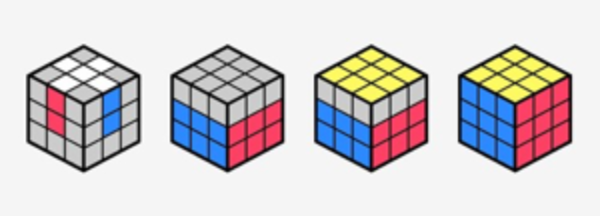THE DIFFERENT METHODS OF SOLVING THE CUBE
The 3×3 Cube is undoubtedly a puzzle of great complexity. This means that, like any complex problem, the cube is amenable to a variety of different ways of analysis and approach until the final solution is found. Over the years many methods have been studied to solve the 3×3 Cube, with the simplest and most popular among cubers of limited experience, being the Beginners’ Method.
Beginners’ Method
This method, whose explanation can be found by clicking this link , is the ideal choice to make one’s first contact with cube solving, as it requires learning a very small number of algorithms, slowly introducing the solver to the basic concepts of the cube. However, the Beginners’ Method inevitably comes a low “ceiling”, resulting at best in solution times of around 25-30 seconds.
Thus, cubers who wish to improve their times even further usually engage in learning new, more complex methods. In this article, the four most widespread of them are mentioned, so that everyone can choose the one that best suits them in order to enhance their solving experience and improve their performance.
CFOP (also known as Fridrich)

CFOP is the most popular method in the world right now and the one used by most world-class cubers. The world record in the 3X3 category has been set, until March 2022, using the CFOP method.
CFOP is characterized by the large number of algorithms required to learn it, as it requires familiarity with 78 basic algorithms (advanced cubers evolve the method even further, assimilating hundreds of additional algorithms).
In one of its most important advantages, CFOP requires comparatively little of the solver’s intuition and initiative. Less need for thinking leads to faster rotation, allowing the top cubers an average rotation speed of 10 moves per second. Thus, CFOP makes up for the time loss that would result from the larger number of overall moves required in its implementation (top cubers need about 55 moves to solve the cube with CFOP, a number quite large compared to other advanced solving methods). In addition, CFOP also transfers extremely well to larger cubes, highly respected by fans of these categories.
Overall, CFOP is a method with high development potential, as hundreds of learning techniques can be found on the internet, as the online community has put its heart and soul into perfecting CFOP in recent years. This makes it the most popular among cubers no longer satisfied by the Beginner’s Method, who wish to effortlessly practice their skills to the next level.
ROUX

Roux is the second most popular method behind CFOP, although its general philosophy is considered to be of opposite nature. It offers the possibility of very ergonomic solutions, with an average of 45 rotations per solve. The limited requirements for cube rotation makes it ideal for one-handed solutions and is therefore often preferred for these events.
Implementing Roux means becoming familiar with just 42 algorithms, a number significantly smaller than the other three speedcubing methods. But while that may help raise the “floor” of your solution times, it also limits the “ceiling” you can reach using Roux. The room for improvement that this method allows is certainly not optimal, which discourages world-class cubers from taking the time to make Roux a part of their skillset.
ZZ

Inspired by Zbigniew Zborowski (whose initials it bears), the ZZ method stands out for its large number of different scenarios. All Front and Back rotations are absent while solving the cube, which helps ZZ achieve very efficient solutions for cubers who are willing to learn all the different algorithms that solve the first and last level of the cube.
The key to perfecting this method is to excel at inspecting the cube and visualize the so-called Edge Orientation (EO) required to solve the white side, as shown in the picture above. Then, the cube’s solution continues seamlessly and quickly, while each cuber can choose from a number of sub-methods to solve the last level.
With the average required rotations usually landing in the 50s, ZZ is preferred to CFOP for One-Handed solutions, but lags behind Roux. Very powerful method for 6X6, 7X7 classes.
PETRUS

The Petrus method is certainly the most unique in terms of the patterns followed as one approaches the final solution. This peculiarity is responsible for its low popularity among the fastest cubers on the planet, thus being untested at the top level.
With average required moves ranging between 40-50, Petrus lags in ergonomics in the early stages of cube solving but incorporates algorithms from ZZ for the latter layer, ultimately improving the rotational speed per second.
Its potential still remains to a certain extent unclear in the cubist community, but its appeal is still on the rise and the database around Petrus is growing by the day. By early 2022, Petrus is a viable method for one-handed events, while in classes above 3X3 remains uncompetitive against CFOP.



